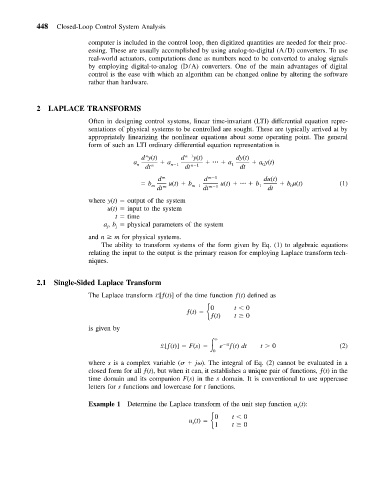Page 457 - Mechanical Engineers' Handbook (Volume 2)
P. 457
448 Closed-Loop Control System Analysis
computer is included in the control loop, then digitized quantities are needed for their proc-
essing. These are usually accomplished by using analog-to-digital (A/D) converters. To use
real-world actuators, computations done as numbers need to be converted to analog signals
by employing digital-to-analog (D/A) converters. One of the main advantages of digital
control is the ease with which an algorithm can be changed online by altering the software
rather than hardware.
2 LAPLACE TRANSFORMS
Often in designing control systems, linear time-invariant (LTI) differential equation repre-
sentations of physical systems to be controlled are sought. These are typically arrived at by
appropriately linearizing the nonlinear equations about some operating point. The general
form of such an LTI ordinary differential equation representation is
n
dy(t) d n 1 y(t) dy(t)
a n a n 1 a 1 ay(t)
0
dt n dt n 1 dt
d m d m 1 du(t)
b m u(t) b m 1 u(t) b 1 bu(t) (1)
0
dt m dt m 1 dt
where y(t) output of the system
u(t) input to the system
t time
a , b physical parameters of the system
j
j
and n m for physical systems.
The ability to transform systems of the form given by Eq. (1) to algebraic equations
relating the input to the output is the primary reason for employing Laplace transform tech-
niques.
2.1 Single-Sided Laplace Transform
The Laplace transform L[ƒ(t)] of the time function ƒ(t) defined as
ƒ(t) 0 t 0
ƒ(t) t 0
is given by
L[ƒ(t)] F(s) e ƒ(t) dt t 0 (2)
st
0
where s is a complex variable ( j ). The integral of Eq. (2) cannot be evaluated in a
closed form for all ƒ(t), but when it can, it establishes a unique pair of functions, ƒ(t)inthe
time domain and its companion F(s) in the s domain. It is conventional to use uppercase
letters for s functions and lowercase for t functions.
Example 1 Determine the Laplace transform of the unit step function u (t):
u (t) 0 t 0
s
s
1
t 0

